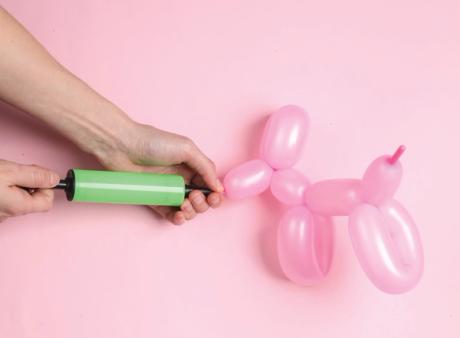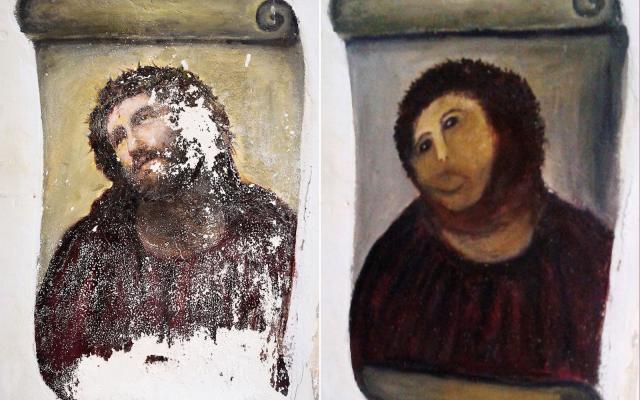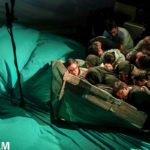Untitled
2016 - Drawing & Print (Drawing & Print)
27.94 x 21.59 cm
James "Yaya" Hough
This untitled ink and pencil drawing by James “Yaya” Hough is made on what the artist calls “institutional paper”, or the state-issued forms that monitor the daily activities of prisoners, of which, each detainee is generally required to fill out in triplicate. This drawing uses a pink form on which an inmate can list telephone contacts for approval. The drawing depicts two uniformed figures, with backwards feet, berating a figure on a toilet. This figure is encapsulated under a head-shaped structure that inhibits the movement of the detainee, while windows in the structure allow the ‘guards’ to surveil the detainee. Behind the seated figure is another lying on a bed, trapped by another mechanical structure, as if in an assembly line. The power of this artwork is two-fold. Firstly, it appropriates and documents the system’s formal processes of control. But is also addresses the artist’s reflections on this method of terror, often through surrealistic, if not nightmarish, imagery in which bodies are sliced, tethered, dominated, and treated like fodder for the machine. To illustrate this relation, the works are framed in such a fashion so that the recto and verso of each document is visible.
Working in ballpoint pen, pencil, and watercolor, often on the backs of bureaucratic prison forms, James “Yaya” Hough’s work conveys the burdens of incarcerated life, revealing not only the brutal reach of the carceral system, but laying bare its affects. Sentenced to life without parole in 1992, Hough went to prison at age 17; after 27 years, the Supreme Court of the United States ruled that such sentences for juveniles is unconstitutional, and Hough was released. The artist, both independently, and as a member of a network of other artists who share a similar history, is one of the key voices working at the intersection of art and the criminal justice system today.
Colors:
Other related works, blended automatically
» see more

© » KADIST
James "Yaya" Hough
2016This untitled ink and pencil drawing by James “Yaya” Hough is made on what the artist calls “institutional paper”, or the state-issued forms that monitor the daily activities of prisoners, of which, each detainee is generally required to fill out in triplicate...
Related works sharing similar palette
» see more

© » THEARTNEWSPER
Neglected middle class may be key to growing stagnant art market Art market Museums & heritage Exhibitions Books Podcasts Columns Technology Adventures with Van Gogh Search Search Art market analysis Neglected middle class may be key to growing stagnant art market The spotlight tends to fall on big spenders, but what of “professional class” buyers, who often feel intimidated by the art world? Scott Reyburn 11 December 2023 Share Injecting new life: initiatives such as Avant Arte and Artist Support Pledge that attract less well-off collectors could revive a flat market Photo: splitov27 Art Basel and UBS recently issued their latest annual Survey of Global Collecting , which analyses the habits and attitudes of more than 2,800 high-net-worth individuals (HNWIs) across the world...

© » ART & OBJECT
5 Art Restoration Fails That Will Blow Your Mind | Art & Object Skip to main content Subscribe to our free e-letter! Webform Your Email Address Role Art Collector/Enthusiast Artist Art World Professional Academic Country USA Afghanistan Albania Algeria American Samoa Andorra Angola Anguilla Antarctica Antigua & Barbuda Argentina Armenia Aruba Ascension Island Australia Austria Azerbaijan Bahamas Bahrain Bangladesh Barbados Belarus Belgium Belize Benin Bermuda Bhutan Bolivia Bosnia & Herzegovina Botswana Bouvet Island Brazil British Indian Ocean Territory British Virgin Islands Brunei Bulgaria Burkina Faso Burundi Cambodia Cameroon Canada Canary Islands Cape Verde Caribbean Netherlands Cayman Islands Central African Republic Ceuta & Melilla Chad Chile China Christmas Island Clipperton Island Cocos (Keeling) Islands Colombia Comoros Congo - Brazzaville Congo - Kinshasa Cook Islands Costa Rica Croatia Cuba Curaçao Cyprus Czechia Côte d’Ivoire Denmark Diego Garcia Djibouti Dominica Dominican Republic Ecuador Egypt El Salvador Equatorial Guinea Eritrea Estonia Eswatini Ethiopia Falkland Islands Faroe Islands Fiji Finland France French Guiana French Polynesia French Southern Territories Gabon Gambia Georgia Germany Ghana Gibraltar Greece Greenland Grenada Guadeloupe Guam Guatemala Guernsey Guinea Guinea-Bissau Guyana Haiti Heard & McDonald Islands Honduras Hong Kong SAR China Hungary Iceland India Indonesia Iran Iraq Ireland Isle of Man Israel Italy Jamaica Japan Jersey Jordan Kazakhstan Kenya Kiribati Kosovo Kuwait Kyrgyzstan Laos Latvia Lebanon Lesotho Liberia Libya Liechtenstein Lithuania Luxembourg Macao SAR China Madagascar Malawi Malaysia Maldives Mali Malta Marshall Islands Martinique Mauritania Mauritius Mayotte Mexico Micronesia Moldova Monaco Mongolia Montenegro Montserrat Morocco Mozambique Myanmar (Burma) Namibia Nauru Nepal Netherlands Netherlands Antilles New Caledonia New Zealand Nicaragua Niger Nigeria Niue Norfolk Island Northern Mariana Islands North Korea North Macedonia Norway Oman Outlying Oceania Pakistan Palau Palestinian Territories Panama Papua New Guinea Paraguay Peru Philippines Pitcairn Islands Poland Portugal Puerto Rico Qatar Romania Russia Rwanda Réunion Samoa San Marino Saudi Arabia Senegal Serbia Seychelles Sierra Leone Singapore Sint Maarten Slovakia Slovenia Solomon Islands Somalia South Africa South Georgia & South Sandwich Islands South Korea South Sudan Spain Sri Lanka St...

© » DAZED DIGITAL
How cute became the defining aesthetic of the internet age | Dazed â¬…ï¸ Left Arrow *ï¸âƒ£ Asterisk â Star Option Sliders âœ‰ï¸ Mail Exit Life & Culture Feature From emojis to coquettes and Hello Kitty, cute’s transformative potential is shaping how we see ourselves both on and off-screen Text Günseli Yalcinkaya 9 February 2024 Cute (2024) 13 When Tim Berners-Lee, the inventor of the World Wide Web, was asked in 2014 to name one use of the internet that he didn’t anticipate, he answered with a single word: kittens...
Other works by: » James "Yaya" Hough
» see more

© » KADIST
James "Yaya" Hough
2016This untitled ink and pencil drawing by James “Yaya” Hough is made on what the artist calls “institutional paper”, or the state-issued forms that monitor the daily activities of prisoners, of which, each detainee is generally required to fill out in triplicate...

© » KADIST
James "Yaya" Hough
2016This untitled ink and pencil drawing by James “Yaya” Hough is made on what the artist calls “institutional paper”, or the state-issued forms that monitor the daily activities of prisoners, of which, each detainee is generally required to fill out in triplicate...
Related works found in the same semantic group
» see more

© » KADIST
Michael Rakowitz
2017The Ballad of Special Ops Cody by Michael Rakowitz is a serio-comic stop motion animated film in which an everyday African-American G...

© » ARTS EQUATOR
"7Voices 2.0" by Yayasan Chow Kit and Dramalab at George Town Festival 2018 | ArtsEquator Thinking and Talking about Arts and Culture in Southeast Asia Articles September 20, 2018 By Akanksha Raja (830 words, four minute read) Before entering the performance space on the first floor lobby of The Whiteaways Arcade where 7Voices 2.0 takes place, my friend Denise and I are approached by two young “inspectors” demanding documentary proof that we were children...

© » KADIST
Olga Grotova
2022Our Grandmothers’ Gardens by Olga Grotova is based on the history of Soviet allotment gardens, which were small plots of land distributed amongst the families of factory workers to compensate for poor food supply in a country that was over-producing weapons...

© » KADIST
Prabhakar Pachpute
2020Calling attention to campaigns for land rights, survival, and sovereignty, Prabhakar Pachpute’s recent works consider how farmers in India use their bodies in performative ways during acts of protest...

